The history of St. Peter Church and Catholicism in Jefferson City can be traced back to just ten years after the founding of the capital city in 1821. Fr. Felix L. Verreydt, S.J., came from the Indian Mission of Portage des Sioux, St. Charles County, Missouri, and celebrated the first documented Mass in Jefferson City in 1831 in the home of Bernard Upschulte, then located on the corner of High and Mulberry Streets. That structure is now located behind the Cole County Historical Museum.
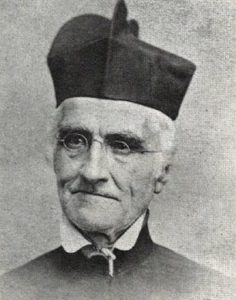 In 1838, Fr. Ferdinand Helias, S.J., newly appointed pastor at Westphalia, Osage County, Missouri, at the request of the visiting Rt. Rev. Joseph Rosati, C.M., first bishop of St. Louis, organized the local Catholics into a community and celebrated Mass in private homes until a site could be selected for a church. Fr. Helias was also the first priest to minister to the inmates of the state prison, located in Jefferson City. The original candlesticks and crucifix that he carried in his saddlebags throughout his ministry are on display in the St. Peter Parish Life Center. The first site for St. Peter Parish Church was the old state capitol building, now the location of the Governor’s Mansion. A petition was presented to the General Assembly to allow local Catholics to purchase the building as the first church. The governor and the Senate approved, but the measure failed the House of Representatives by just four votes. The first Catholic Church in Jefferson City was then constructed in 1845-46 on the present site of St. Peter School. The structure was a 30 by 22 foot oak-board building built by 18 men from the forest wilderness that comprised Jefferson City at the time. Fr. Helias named the new church building in honor of St. Ignatius Loyola, the founder of the Society of Jesus, also known as the Jesuits.
In 1838, Fr. Ferdinand Helias, S.J., newly appointed pastor at Westphalia, Osage County, Missouri, at the request of the visiting Rt. Rev. Joseph Rosati, C.M., first bishop of St. Louis, organized the local Catholics into a community and celebrated Mass in private homes until a site could be selected for a church. Fr. Helias was also the first priest to minister to the inmates of the state prison, located in Jefferson City. The original candlesticks and crucifix that he carried in his saddlebags throughout his ministry are on display in the St. Peter Parish Life Center. The first site for St. Peter Parish Church was the old state capitol building, now the location of the Governor’s Mansion. A petition was presented to the General Assembly to allow local Catholics to purchase the building as the first church. The governor and the Senate approved, but the measure failed the House of Representatives by just four votes. The first Catholic Church in Jefferson City was then constructed in 1845-46 on the present site of St. Peter School. The structure was a 30 by 22 foot oak-board building built by 18 men from the forest wilderness that comprised Jefferson City at the time. Fr. Helias named the new church building in honor of St. Ignatius Loyola, the founder of the Society of Jesus, also known as the Jesuits.
The Jesuits soon turned the care of the new mission over to Archbishop Peter R. Kenrick in St. Louis, and in 1846 the Archbishop named Fr. James S. Murphy the first resident pastor. When Fr. Murphy dedicated the new church, he named it in honor of St. Peter, the Prince of the Apostles and the patron saint of his Archbishop. St. Peter Catholic Church became the 59th parish of the St. Louis Archdiocese. The young church building served the parish community for 12 years until the growth of the Catholic population forced Fr. William Walsh, the fourth pastor, to construct the second St. Peter church structure on the corner of Broadway and High Streets. It was built of brick and dedicated in 1856 on a plot of land purchased for $600. The Jefferson Inquirer, the city newspaper of the time, declared the new brick building to be the “handsomest building in the city.”
The History of the Diocese of St. Louis, in speaking of St. Peter Parish, Jefferson City, states: “In 1838 there were nine families; in 1855 there were forty,” (page 360). The fledgling parish was indeed growing. The brick church served its function until 1881 when Msgr. Otto Joseph Stanislaus Hoog, the seventh pastor, had it razed to make way for the present church.
Saint Peter Church
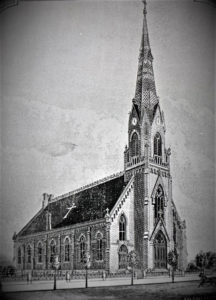 The present church was designed by Adolph Druiding and constructed by Fred H. Binder with 800,000 bricks donated by G.H. Dulle. It was placed on the National Register of Historic Places on June 18, 1976. The gothic church is 173 and one half feet in length and 60 feet in width. The clock tower and steeple, a city landmark, rises to a height of 170 feet. The tower contains four bells cast by the Stuckstede Foundry with an aggregate weight of 8,000 pounds, purchased at a cost of $1,354 and dedicated to St. Peter (55 inches in diameter), St. Joseph (46 inches), The Sacred Heart of Jesus (34 inches), and The Blessed Virgin Mary (28 inches). It is impossible to separate our parish history from the history of Jefferson City and the city’s role as the seat of state government. In 1911, during the fire at the State Capitol building the Missouri State House of Representatives used St. Peter’s School library to conduct business for the remainder of that legislative session. Gov. Joseph P. Teasdale, 1977-81, was a member of St. Peter and frequently attended noon Mass.
The present church was designed by Adolph Druiding and constructed by Fred H. Binder with 800,000 bricks donated by G.H. Dulle. It was placed on the National Register of Historic Places on June 18, 1976. The gothic church is 173 and one half feet in length and 60 feet in width. The clock tower and steeple, a city landmark, rises to a height of 170 feet. The tower contains four bells cast by the Stuckstede Foundry with an aggregate weight of 8,000 pounds, purchased at a cost of $1,354 and dedicated to St. Peter (55 inches in diameter), St. Joseph (46 inches), The Sacred Heart of Jesus (34 inches), and The Blessed Virgin Mary (28 inches). It is impossible to separate our parish history from the history of Jefferson City and the city’s role as the seat of state government. In 1911, during the fire at the State Capitol building the Missouri State House of Representatives used St. Peter’s School library to conduct business for the remainder of that legislative session. Gov. Joseph P. Teasdale, 1977-81, was a member of St. Peter and frequently attended noon Mass.
The interior of the church retains the gothic design. Two majestic tiers of fourteen pillars support the ceiling, dividing the church into three naves. The height of the center nave is 56 feet; the two side naves are 42 feet. Three gothic reredos are carved of white walnut with rich gilt. The center reredos, which houses the tabernacle, is 49 feet high. It contains a center statue of the Sacred Heart of Jesus. The two lower niches contain statues of St. Peter, with keys, and St. Paul, Apostle to the Gentiles, with a sword.
The side reredos are 24 feet in height. The shrine to the Blessed Mother contains statues of St. Agnes, patroness of virgins, with a lamb, and St. Rose of Lima with the Christ child, patroness of South America (a link which the Diocese of Jefferson City has had through missionary work in Peru). On the opposite side is a statue of St. Joseph, accompanied by one of St. Aloysius Gonzaga, patron of youth, with a crucifix, and another of St. Francis de Sales, patron of authors, journalists and the deaf with a book.
The present church’s service to Jefferson City began on February 2, 1883, when Monsignor Hoog celebrated the first Mass. It was solemnly dedicated on August 12, 1883, by the Rt. Rev. Patrick J. Ryan, Coadjutor Bishop of St. Louis.
New Diocese and First Cathedral
Upon the decision of Pope Pius XII in 1956, the State of Missouri was divided into four dioceses, and the Diocese of Jefferson City was formed. St. Peter Church was selected as the first Cathedral of the new diocese by Bishop Joseph M. Marling, C.PP.S. For 12 years, from his installation in 1956 until Christmas Eve 1968, St. Peter was the mother church of the Diocese, when the cathedral’s jurisdiction was transferred to St. Joseph Parish. St. Peter Cathedral was the site of many priestly ordinations, including that of the first priest of the diocese, Fr. John W. Buchanan, in 1957, who would return as the eleventh pastor of St. Peter in 1972.
Another history making event for St. Peter took place in 1962 when it became the church of departure for the first group of diocesan missionaries to Peru commissioned by Bishop Marling. Still another historical event for St. Peter Church was being the site, on Holy Thursday, 1965, for the first concelebrated Mass in the diocese. Monsignor Joseph A. Vogelweid, P.A., associated with St. Peter’s for over 60 years, was the diocese’s first Vicar General and the only rector of St. Peter Cathedral. Monsignor played a role in the foundation of the Carmelite Monastery, St. Joseph’s Home for the Aged, and the establishment of the Veteran’s Day Mass at St. Peter. Upon his retirement in 1969, his assistant for 17 years, Fr. Norman J. Ahrens, became the tenth pastor.
Major Renovations: 1980s & 1990s
In 1982, the Church was extensively renovated in preparation to celebrate its centennial year and to respond to the liturgical changes begun with the Second Vatican Council. In the construction of a new free-standing altar, portions of the former communion rail were used. The pulpit was modified and two rooms for the Sacrament of Reconciliation were developed. The baptismal font, purchased in 1888, was restored to its original condition. Central air conditioning and a restroom were added, and a new roof was installed.
In 1987, the Wicks pipe organ was renovated and thirteen ranks of pipes were added by the Quimby Pipe Organ Company.
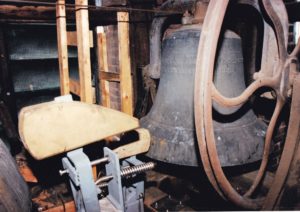 In 1989, repairs were done on the bell tower and lights were installed to illuminate the tower and clocks at night. That same year, every roof of every building was replaced or repaired.
In 1989, repairs were done on the bell tower and lights were installed to illuminate the tower and clocks at night. That same year, every roof of every building was replaced or repaired.
A restoration of the bell tower began June 1, 1995 and was completed that summer. A new bell ringing system using four electromagnetic hammers was installed. Every four years the new governor is sworn into office at the ringing of the noonday Angelus from St. Peter’s bells.
Some 2,000 missing, broken and deteriorating bricks were replaced and tuck-pointing was done during this time. Twelve new concrete fleurs-de-lis were cast and put in place. The copper louvers were repaired and the crosses were painted. Brick and stone sealer was applied. Inside the tower, stairs and ladders were repaired and two platforms constructed.
Adorning the exterior of the bell tower are four clocks, one on each side. The clock’s restoration included new hands fashioned from aluminum and painted black. The previous hands were made out of wood, and warped after a period of time due to the weather. The new hands were made to fit the 54-inch opening of the dial and are exact replicas of the original clock hands.
Major Renovations: 2002
In 2002, the interior was again refinished. Numerous photographs of the church were studied from various times in its history so that the artwork from these historic times could be incorporated into the renovation. The colors chosen for the Church décor were determined by the colors in the stained glass windows and the exterior bricks and stone.
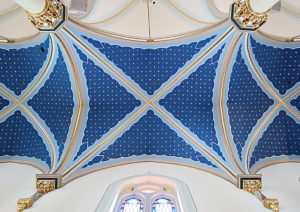 The side naves received a celestial sky treatment with clouds and stars while the center nave contains stenciling that reminds us of the five wounds of Christ. The red drop reminds us of the blood of Christ shed for us. It is surrounded by the nails of the crucifixion.
The side naves received a celestial sky treatment with clouds and stars while the center nave contains stenciling that reminds us of the five wounds of Christ. The red drop reminds us of the blood of Christ shed for us. It is surrounded by the nails of the crucifixion.
The three reredos were removed for their restoration and the original butternut stain color was discovered on the side panel of the St. Joseph altar as well as the original stenciling on the walls. The designs consist of St. Mary’s monogram, S/M with her symbol, the rose, and St. Joseph’s monogram, S/J, with the lily.
The church interior committee decided to place a mural of the Divine Mercy on the face of the triumphal arch over the sanctuary. This is the same location of a previous mural, which had deteriorated beyond repair and had to be removed during the 1982 renovation. That mural was thought to be of the Holy Family with angels hovering nearby.
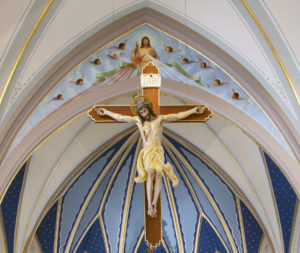 The new mural of the Divine Mercy is the image of Jesus revealed to St. Faustina. Jesus stated to St. Faustina: The two rays denote Blood and Water. The pale ray stands for the Water which makes souls righteous. The red ray stands for the Blood which is the life of souls. These two rays issued forth from the depths of My tender mercy when My agonized Heart was opened by a lance on the Cross. Happy is the one who will dwell in their shelter, for the just hand of God shall not lay hold of him. By means of this image I shall grant many graces to souls. It is to be a reminder of the demands of My mercy, because even the strongest faith is of no avail without works.
The new mural of the Divine Mercy is the image of Jesus revealed to St. Faustina. Jesus stated to St. Faustina: The two rays denote Blood and Water. The pale ray stands for the Water which makes souls righteous. The red ray stands for the Blood which is the life of souls. These two rays issued forth from the depths of My tender mercy when My agonized Heart was opened by a lance on the Cross. Happy is the one who will dwell in their shelter, for the just hand of God shall not lay hold of him. By means of this image I shall grant many graces to souls. It is to be a reminder of the demands of My mercy, because even the strongest faith is of no avail without works.
The words, “Jesus, I trust in You,” are always presented with this image.
Ten angels surround Jesus adoring him. As the artist was looking for models for the angels, she noticed there were quite a variety of nationalities represented in St. Peter Parish. The angels’ faces represent children from various races and cultures including African, Asian, European, Filipino, Middle Eastern, Native American, and Hispanic. While some of the faces are actually based on individual parishioners, some are composites of two or more children’s faces.
Many members of the parish expressed a desire to have the parish’s large crucifix once again suspended over the altar which was removed in the 1982 renovation. The decision was made to move the altar forward a distance of fourteen feet from where it had been since the 1982 renovation and suspend the crucifix above the altar at the new location.
The baldachin, which originally hung over the pulpit, but was separated from the pulpit in the 1982 renovation, was moved from the wall on which it hung to the pillar which is directly next to the pulpit, thus restoring the original unity of the baldachin with the pulpit. A mural of the Holy Spirit in the form of a dove adorns the underside of the baldachin. The lighting and sound system was upgraded during that time.
New oak pews were purchased, as the pews (made of fiberboard), which were installed in the 1982 renovation had reached their life expectancy of 20-25 years. The new solid oak pews are in a style consistent with the architecture of the church.
The Stations of the Cross, which had been whitewashed during the previous renovation, were stripped of paint and restored, as much as possible, to their original colors.
The work of the completed renovation was celebrated in a mass with Bishop Gaydos on December 21, 2002.
Major Renovations: 2020-2021
Through the generosity of the estate of Ethel Bruning, the rotted and warped doors at the main entrance of the church were replaced.
 The night of March 27, 2020 a storm hit Jefferson City bringing with it hail as large as grapefuit. Every parish building received significant impacts from the hailstorm. Four windows on the apse of the church were broken and the church tower received further damage.
The night of March 27, 2020 a storm hit Jefferson City bringing with it hail as large as grapefuit. Every parish building received significant impacts from the hailstorm. Four windows on the apse of the church were broken and the church tower received further damage.
A decision was made prior to the beginning of construction to take the opportunity to restore the roof of the church and steeple to its original form. This included restoring the cross motif on both sides of the nave roof using red slate from Vermont.
In anticipation of the roofing renovation on St. Peter Church a structural evaluation of the roof structure above the vaults was conducted. It was noted that the rock wool insulation that was installed in the 1940s in the attic space had an approximate R-value of 10 while the recommended minimum R-value in our geographic area is R-38. New fiberglass insulation was added in the church attic space, above the sacristies and the pitched roofs of the vestibules brought the insulation up to R-40.
After several months of waiting for the insurance company to finalize a Scope of Work, restoration of St. Peter Church and the parish’s buildings began the week of August 9, 2020 with the erection of scaffolding around the church.
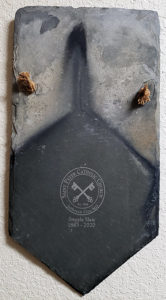 The original 137-year-old slate on the steeple was removed and made available to parishioners as keepsakes. It was discovered that five of the slate tiles on the steeple had bullet holes. Full tiles were engraved with the new St. Peter Church emblem and smaller pieces were turned into Christmas ornaments. The original square nails were crafted into crosses.
The original 137-year-old slate on the steeple was removed and made available to parishioners as keepsakes. It was discovered that five of the slate tiles on the steeple had bullet holes. Full tiles were engraved with the new St. Peter Church emblem and smaller pieces were turned into Christmas ornaments. The original square nails were crafted into crosses.
During the course of the restoration several discoveries were made regarding the deterioraton of the bricks, limestone, underlayment and decking. The steeple decking had been compromised to the point where it could not reliably hold a nail.
Over 600 linear square feet of new 1×8’s were used in the re-decking of the steeple. As work progressed up the steeple vertical structural members needed to be reinforced with new 2″ lumber. It was discovered that each of the original vertical members were inscribed with Roman numerals.
Repairs were made to the seven apse windows, many of which incurred hail damage to the protective glass and frames. There were also a number of pieces of the stained glass itself which had cracked, bowed and buckled because of the buildup of heat between the protective glass and the stained glass that softened the leading between the individual pieces of glass.
In November 2020, the original copper crosses were removed from both ends of the church. Because of significant damage to the crosses, new ones were fashioned of copper in an identical manner. The gilding on the new crosses were funded through the generosity of Edith Vogel.
A 170′ crane was used to remove more than 12,000 pounds of capstones from the west parapet wall which were replaced with new Indiana limestone. During the removal process two chimney flues were discovered near the top of the wall. The flues, long covered over, would have been from the time that multiple wood stoves heated the church.
In January 2021, installation of the slate on the steeple began. A historically sensitive pattern for the slate was developed to accentuate the cross that crowns the steeple.
Beginning at the twenty-fourth course of slate and again at the twenty-sixth course are two horizontal lines of red slate which are symbolic of the two natures of Christ. At the forty-second course is a single line of red slate symbolic of the union of the human and devine natures of Christ in one Divine person, which is called the Hypostatic Union. At the sixtieth course, a single red slate is placed on the cardinal directions of the steeple, indicating that the Gospel is meant to be proclaimed in every direction. Finally, between the twenty-sixth and sixtieth courses of red slate, there are thirty-three courses of slate symbolic of the thirty-three years of our Lord’s earthly life.
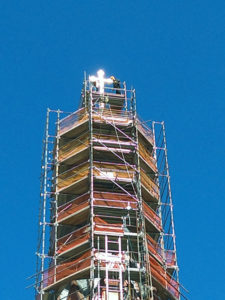 In April 2021 the new steeple cross was installed on a beautiful spring day. School children from St. Peter School were in attendance along with parishioners, the news media, Jefferson City Mayor Carrie Tergin and Lt. Governor Mike Kehoe.
In April 2021 the new steeple cross was installed on a beautiful spring day. School children from St. Peter School were in attendance along with parishioners, the news media, Jefferson City Mayor Carrie Tergin and Lt. Governor Mike Kehoe.
Finally, after more than nine months of construction, the scaffolding was removed and the exterior restoration was completed.
Next up was restoration of the interior of the church at the request of Bishop W. Shawn McKnight and under the guidance of architect William Heyer.
Building upon the restoration that was begun twenty years earlier the freestanding altar was restored to its befitting location in the sanctuary of the church. This allowed for the pews on the sides to be reoriented and increase seating capacity with additional ADA-compliant seating.
As a result of damage from chemicals used to sanitize the church due to COVID-19 and two decades of continuous use, the existing pews needed to be refinished and new kneelers installed as a result of deterioration of padding and structure.
The pulpit remained in its current location but restored to its original artistry with statues of the four Evangelists recreated and attached to the structure.
New hardwood flooring was installed throughout the sanctuary and nave with carpet runners in the aisle to absorb sound and for ease of cleaning.
The reconfigured confessionals offer improved soundproofing to ensure confidentiality of the Sacrament is maintained. Lessons from the COVID-19 pandemic warranted better air flow and designated space between the priest and penitent.
In order to make the side shrines of the Blessed Virgin Mary and St. Joseph more visible and to accommodate the increased number of faithful who receive Holy Communion kneeling the existing communion rails were moved down two steps and made functional. The high altar was also restored and made functional for when the Extraordinary Form of the Mass is offered.
St. Peter Church began its life of service to Jefferson City and the surrounding areas in 1846 to fourteen Catholic families. Now, 175 years later, St. Peter Church serves over 1300 Catholic families.
Rev. S.J. Orf stated in the Souvenir of the Golden Jubilee of St. Peter’s Parish: “I conclude my description by applying to our church the lines written by the enrapture poet:
‘Majesty, Power, Glory, Strength and Beauty are all aisled
In this eternal ark of worship undefiled.'”
